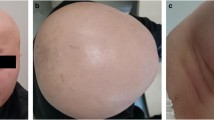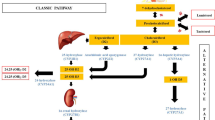Abstract
Hereditary vitamin D-resistant rickets (HVDRR), an autosomal recessive disorder caused by inactivating mutations in the vitamin D receptor (VDR) gene. We identified two affected children from the same family, one at the age of 10 years and 9 months and the other at 9 months old. Mutation analysis by PCR-sequencing the entire coding region of the VDR gene revealed a homozygous C to T transition in exon 2 of the VDR gene (c.148C>T) resulting in a stop codon at amino acid position 50 (p.R50X) in the proband and his younger sister. The p.R50X has never been previously described. Both asymptomatic parents were heterozygous for the mutation. In addition to most of the clinical features of HVDRR including total alopecia, symptoms of hypocalcemia at a later onset and normophosphatemia, rarely found in HVDRR were present in the proband. This study also emphasizes an important role of genetic testing for early diagnosis and genetic counseling.


Similar content being viewed by others
Abbreviations
- HVDRR:
-
Hereditary vitamin D-resistant rickets
- VDR:
-
Vitamin D receptor
- PTH:
-
Parathyroid hormone
References
M.R. Hughes, P.J. Malloy, D.G. Kieback, R.A. Kesterson, J.W. Pike, D. Feldman, B.W. O’Malley, Point mutations in the human vitamin D receptor gene associated with hypocalcemic rickets. Science 242, 1702–1705 (1988)
H.H. Ritchie, M.R. Hughes, E.T. Thompson, P.J. Malloy, Z. Hochberg, D. Feldman, J.W. Pike, B.W. O’Malley, An ochre mutation in the vitamin D receptor gene causes hereditary 1,25-dihydroxyvitamin D3-resistant rickets in three families. Proc. Natl. Acad. Sci. USA 86, 9783–9787 (1989)
P.J. Malloy, J.W. Pike, D. Feldman, The vitamin D receptor and the syndrome of hereditary 1,25-dihydroxyvitamin D-resistant rickets. Endocr. Rev. 20, 156–188 (1999)
M.H. Brooks, N.H. Bell, L. Love, P.H. Stern, E. Orfei, S.F. Queener, A.J. Hamstra, H.F. DeLuca, Vitamin-D-dependent rickets type II. Resistance of target organs to 1,25-dihydroxyvitamin D. N. Engl. J. Med. 298, 996–999 (1978)
H. Yagi, K. Ozono, H. Miyake, K. Nagashima, T. Kuroume, J.W. Pike, A new point mutation in the deoxyribonucleic acid-binding domain of the vitamin D receptor in a kindred with hereditary 1,25-dihydroxyvitamin D-resistant rickets. J. Clin. Endocrinol. Metab. 76, 509–512 (1993)
Z. Hochberg, Vitamin-D-dependent rickets type 2. Horm. Res. 58, 297–302 (2002)
M.R. Haussler, C.A. Haussler, P.W. Jurutka, P.D. Thompson, J.C. Hsieh, L.S. Remus, S.H. Selznick, G.K. Whitfield, The vitamin D hormone and its nuclear receptor: molecular actions and disease states. J. Endocrinol. 154, S57–S73 (1997)
P. Katavetin, P. Katavetin, S. Wacharasindhu, V. Shotelersuk, A girl with a novel splice site mutation in VDR supports the role of a ligand-independent VDR function on hair cycling. Horm. Res. 66, 273–276 (2006)
K. Kristjansson, A.R. Rut, M. Hewison, J.L. O’Riordan, M.R. Hughes, Two mutations in the hormone binding domain of the vitamin D receptor cause tissue resistance to 1,25 dihydroxyvitamin D3. J. Clin. Investig. 92, 12–16 (1993)
R.J. Wiese, H. Goto, J.M. Prahl, S.J. Marx, M. Thomas, A. Al-Aqeel, H.F. De Luca, Vitamin D-dependency rickets type II: truncated vitamin D receptor in three kindreds. Mol. Cell. Endocrinol. 90, 197–201 (1993)
F.J. Cockerill, N.S. Hawa, N. Yousaf, M. Hewison, J.L. O’Riordan, S.M. Farrow, Mutations in the vitamin D receptor gene in three kindreds associated with hereditary vitamin D resistant rickets. J. Clin. Endocrinol. Metab. 82, 3156–3160 (1997)
J.B. Mechica, M.O. Leite, B.B. Mendonca, E.S. Frazzatto, A. Borelli, A.C. Latronico, A novel nonsense mutation in the first zinc finger of the vitamin D receptor causing hereditary 1,25-dihydroxyvitamin D3-resistant rickets. J. Clin. Endocrinol. Metab. 82, 3892–3894 (1997)
W. Zhu, P.J. Malloy, E. Delvin, G. Chabot, D. Feldman, Hereditary 1,25-dihydroxyvitamin D-resistant rickets due to an opal mutation causing premature termination of the vitamin D receptor. J. Bone Miner. Res. 13, 259–264 (1998)
P.J. Malloy, W. Zhu, R. Bouillon, D. Feldman, A novel nonsense mutation in the ligand binding domain of the vitamin D receptor causes hereditary 1,25-dihydroxyvitamin D-resistant rickets. Mol. Genet. Metab. 77, 314–318 (2002)
Y. Zhou, J. Wang, P.J. Malloy, Z. Dolezel, D. Feldman, Compound heterozygous mutations in the vitamin D receptor in a patient with hereditary 1,25-dihydroxyvitamin D-resistant rickets with alopecia. J. Bone Miner. Res. 24, 643–651 (2009)
S. Beer, M. Tieder, D. Kohelet, O.A. Liberman, E. Vure, G. Bar-Joseph, D. Gabizon, Z.U. Borochowitz, M. Varon, D. Modai, Vitamin D resistant rickets with alopecia: a form of end organ resistance to 1,25 dihydroxy vitamin D. Clin. Endocrinol. (Oxf) 14, 395–402 (1981)
S.J. Marx, M.M. Bliziotes, M. Nanes, Analysis of the relation between alopecia and resistance to 1,25-dihydroxyvitamin D. Clin. Endocrinol. (Oxf) 25, 373–381 (1986)
P.J. Malloy, W. Zhu, X.Y. Zhao, G.B. Pehling, D. Feldman, A novel inborn error in the ligand-binding domain of the vitamin D receptor causes hereditary vitamin D-resistant rickets. Mol. Genet. Metab. 73, 138–148 (2001)
J. Miller, K. Djabali, T. Chen, Y. Liu, M. Ioffreda, S. Lyle, A.M. Christiano, M. Holick, G. Cotsarelis, Atrichia caused by mutations in the vitamin D receptor gene is a phenocopy of generalized atrichia caused by mutations in the hairless gene. J. Investig. Dermatol. 117, 612–617 (2001)
R. Bergman, R. Schein-Goldshmid, Z. Hochberg, O. Ben-Izhak, E. Sprecher, The alopecias associated with vitamin D-dependent rickets type IIA and with hairless gene mutations: a comparative clinical, histologic, and immunohistochemical study. Arch. Dermatol. 141, 343–351 (2005)
J.C. Hsieh, J.M. Sisk, P.W. Jurutka, C.A. Haussler, S.A. Slater, M.R. Haussler, C.C. Thompson, Physical and functional interaction between the vitamin D receptor and hairless corepressor, two proteins required for hair cycling. J. Biol. Chem. 278, 38665–38674 (2003)
P.J. Malloy, R. Xu, A. Cattani, L. Reyes, D. Feldman, A unique insertion/substitution in helix H1 of the vitamin D receptor ligand binding domain in a patient with hereditary 1,25-dihydroxyvitamin D-resistant rickets. J. Bone Miner. Res. 19, 1018–1024 (2004)
P.J. Malloy, R. Xu, L. Peng, S. Peleg, A. Al-Ashwal, D. Feldman, Hereditary 1,25-dihydroxyvitamin D resistant rickets due to a mutation causing multiple defects in vitamin D receptor function. Endocrinology 145, 5106–5114 (2004)
G.K. Whitfield, S.H. Selznick, C.A. Haussler, J.C. Hsieh, M.A. Galligan, P.W. Jurutka, P.D. Thompson, S.M. Lee, J.E. Zerwekh, M.R. Haussler, Vitamin D receptors from patients with resistance to 1,25-dihydroxyvitamin D3: point mutations confer reduced transactivation in response to ligand and impaired interaction with the retinoid X receptor heterodimeric partner. Mol. Endocrinol. 10, 1617–1631 (1996)
P.J. Malloy, R. Xu, L. Peng, P.A. Clark, D. Feldman, A novel mutation in helix 12 of the vitamin D receptor impairs coactivator interaction and causes hereditary 1,25-dihydroxyvitamin D-resistant rickets without alopecia. Mol. Endocrinol. 16, 2538–2546 (2002)
N.S. Ma, P.J. Malloy, P. Pitukcheewanont, D. Dreimane, M.E. Geffner, D. Feldman, Hereditary vitamin D resistant rickets: identification of a novel splice site mutation in the vitamin D receptor gene and successful treatment with oral calcium therapy. Bone 45, 743–746 (2009)
P.J. Malloy, D. Feldman, Genetic disorders and defects in vitamin D action. Endocrinol. Metab. Clin. North Am. (2010) 39, 333–346
P.J. Malloy, J. Wang, T. Srivastava, D. Feldman, Hereditary 1,25-dihydroxyvitamin D-resistant rickets with alopecia resulting from a novel missense mutation in the DNA-binding domain of the vitamin D receptor. Mol. Genet. Metab. 99, 72–79 (2010)
Y. Weisman, I. Bab, D. Gazit, Z. Spirer, M. Jaffe, Z. Hochberg, Long-term intracaval calcium infusion therapy in end-organ resistance to 1,25-dihydroxyvitamin D. Am. J. Med. 83, 984–990 (1987)
Acknowledgments
We would like to thank the patients and their family for participation in this study. We are grateful to Chalurmpon Srichomthong and Siriprapa Tongkobpech for technical assistance. This study was supported by the Faculty of Medicine, Chulalongkorn University, National Science and Technology Development Agency, the Thailand Research Fund, the National Research University Project of CHE and the Ratchadapiseksomphot Endowment Fund (HR1163A).
Author information
Authors and Affiliations
Corresponding author
Rights and permissions
About this article
Cite this article
Supornsilchai, V., Hiranras, Y., Wacharasindhu, S. et al. Two siblings with a novel nonsense mutation, p.R50X, in the vitamin D receptor gene. Endocrine 40, 62–66 (2011). https://doi.org/10.1007/s12020-011-9450-9
Received:
Accepted:
Published:
Issue Date:
DOI: https://doi.org/10.1007/s12020-011-9450-9




